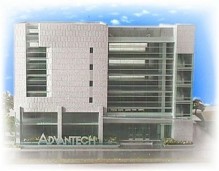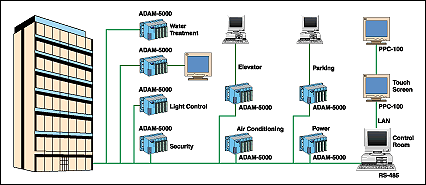ADAM-4000 & ADAM-5000 Modules Used
as the Heart of a Progressively Constructed Building Automation
System
 Advantech
has designed a comprehensive building automation system for
its home office using Advantech components. The system is divided
into seven subsystems: power management, security detection,
lighting control, air conditioning, parking management, water/wastewater
management and elevator monitoring. Each subsystem is to be
developed and built independently, but integrated into a whole
building automation system. In order to make integration simpler,
ADAM-4000
and ADAM-5000
distributed data acquisition and control modules and VisiDAQ
3.1 man machine interface software are used to progressively
construct this system. Advantech
has designed a comprehensive building automation system for
its home office using Advantech components. The system is divided
into seven subsystems: power management, security detection,
lighting control, air conditioning, parking management, water/wastewater
management and elevator monitoring. Each subsystem is to be
developed and built independently, but integrated into a whole
building automation system. In order to make integration simpler,
ADAM-4000
and ADAM-5000
distributed data acquisition and control modules and VisiDAQ
3.1 man machine interface software are used to progressively
construct this system.
System
Requirements
The Advantech building automation system demonstrates the use
of distributed data acquisition and control technology and multi-layer
architecture in setting up multiple monitoring and control centers.
The concept works like this: A number of sensors are located
throughout the building to measure the parameters of interest.
These are connected via RS-485 networks to ADAM modules, which
may be mounted separately (ADAM-4000 series) or may be snapped
into an ADAM system (ADAM-5000 series). ADAM systems are connected
via RS-485 networks to monitoring and control centers. Each
monitoring and control center is integrated into a local area
network (LAN) to share information. Each monitoring and control
center polls the ADAM systems to monitor their operational status
and to collect their data outputs, which were collected from
the sensors. The outputs are displayed using the VisiDAQ 3.1
man-machine interface
System
Architecture
Several components of the building automation system have
already been built and deployed, including the air conditioning
subsystem. This subsystem monitors and controls the temperature
at Advantech's main office. The building is divided into key
areas, with each area controlled by a host PC running Windows-based
VisiDAQ 3.1 software. Every point of measurement has a thermocouple
connected to an ADAM-4011
analog input module, along with an ADAM-4060
relay output module. All modules connect to the host computer
through an RS-485 twisted pair interface. The ADAM-4011 reads
the thermocouple voltage and converts it into temperature,
which is then sent to the host. VisiDAQ 3.1 displays the temperature
and constantly checks it. When the temperature rises above
a preset maximum limit, VisiDAQ 3.1 orders the ADAM-4060 relay
output module to turn on the air conditioning in that specific
area. When the temperature returns to the set-point, VisiDAQ
3.1 orders the relay module to turn the air conditioning off.

Conclusion
Using ADAM-4000 and ADAM-5000 distributed data acquisition
and control modules and VisiDAQ 3.1 software, a PC can be
used as the heart of a progressively constructed building
automation system. Since the building automation system is
based on PC architecture, you can easily integrate information
from the building automation system into other information
systems. The PC-based architecture reduces the costs of maintenance
and upgrades.
Contact
Advantech Industrial Automation for More Information:
website: http://www.advantech.com/ia
Email: info@advantech.com
Advantech Industrial Automation Office locator: Click
Here

|
|
|

